Finnegans Wake – A Prescriptive Guide – 12
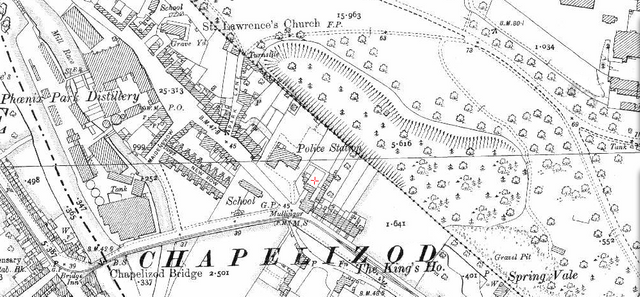
through their struts of Chapelldiseut
If you bear west from the centre of Dublin, keeping the River Liffey on your left hand and the Phoenix Park on your right, you will soon find yourself in the village of Chapelizod. This picturesque little hamlet on the western outskirts of the city has managed to retain much of its old-world charm at a time when so many of Dublin’s outlying villages are being swallowed up and homogenized by the ever-expanding metropolis. Nestled between the river and the park, Chapelizod has resisted for decades the sort of development that has transformed sleepy villages into noisy suburbs, and quiet country roads into busy thoroughfares. It is only in recent years—since the turn of the millennium, in fact—that the flowing tide of urbanization has finally begun to engulf this little island of Old Dublin.
The village of Chapelizod owes its name—allegedly—to the fabled Isolde of Arthurian romance. It is said, by some, that she and her adulterous lover Tristram consummated their love in this spot (Gifford 81). The truth is somewhat more mundane. The name is Norman, and the history of Chapelizod probably does not extend any further back than 1170, when the Anglo-Normans captured Dublin. One website gives the following gloss for the Irish name of the village Séipéal Iosóid:
The chapel of Iosóid
Iosóid — Anglo-Norman personal name (Old French Iseut, Isaut).
The historian Stanihurst said the following about this placename in 1577:
There ſtandeth néere the caſtle, ouer againſt a voyde rowme, called Preſton his Innes, a tower, named, Iſoudes tower. It tooke the name of La Beale Iſoude, daughter to Anguiſhe, king of Irelande. ... There is a village harde by Dublynne, called of the ſayde La Beale, Chappell Iſoude.
[There stands near Dublin Castle, opposite an open space called Preston’s Inns, a tower named Isoude’s Tower. It took the name of The Fair Isoude, daughter of Anguishe, King of Ireland. ... There is a village close to Dublin named for the same woman, Chapel Isoude.]
—Holinshed’s Chronicles of England, Scotland and Ireland (1577) Vol. 3, 1.2.
The above form and earlier forms such as 1212 “ecclesia de Ysoude” from Pontificia Hibernica show that the qualifying element here is the Old French name Iseut/Isaut. Other historical forms reflect the Latinised form Isolda (e.g. 1229 “Capella Isolde”, Calendar of Documents Relating to Ireland I, 260) and, later, Isard (c.1654 “Chappelizard”, Civil Survey)—see the English surname Iz(z)ard, which is of the same origin. (Logainm)
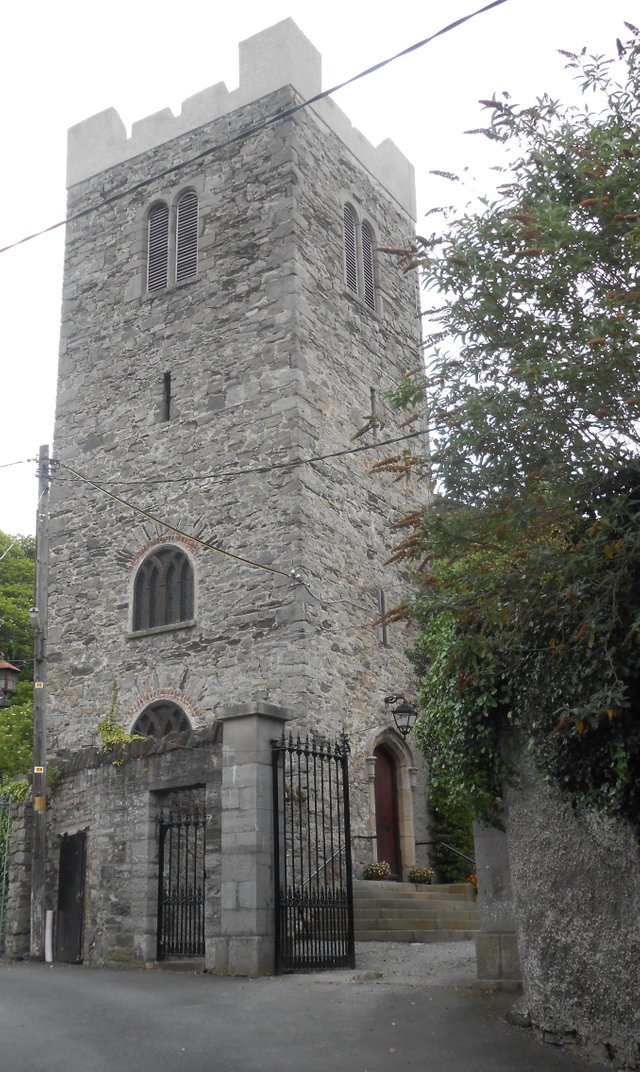
After the Norman Invasion, Chapelizod became a royal manor. Over the next few centuries it was leased to a succession of prominent Anglo-Norman families and, for a time, to the Priory of the Hospitallers of St John of Jerusalem. The village which grew up around the manor was provided with defensive walls in the 13th century. Early in the 17th century it became the property of Sir Henry Power, who built the well-known King’s House on the left bank of the Liffey. It owes its name to William III, who stayed there in July 1690, just a few weeks after his victory in the Battle of the Boyne. In the 18th century Chapelizod acquired a reputation for rakish entertainment. Among its popular watering holes were The Ship Tavern, The Three Tuns and Grapes, The Salmon House and The Phoenix. This is the Chapelizod in which Sheridan Le Fanu set his novel The House by the Churchyard, which provided Joyce with a rich crop of allusions for Finnegans Wake. (Ball 163-178)

Chapelizod has a village square—an innovation introduced to this country by the Normans and Saxons—in which there once stood a noble elm tree (Mink 257). Chapelizod Square is really a triangle. To the east of the village was a turnpike—a toll gate—which was established in the 18th century and abolished in 1853 (Mink 521).
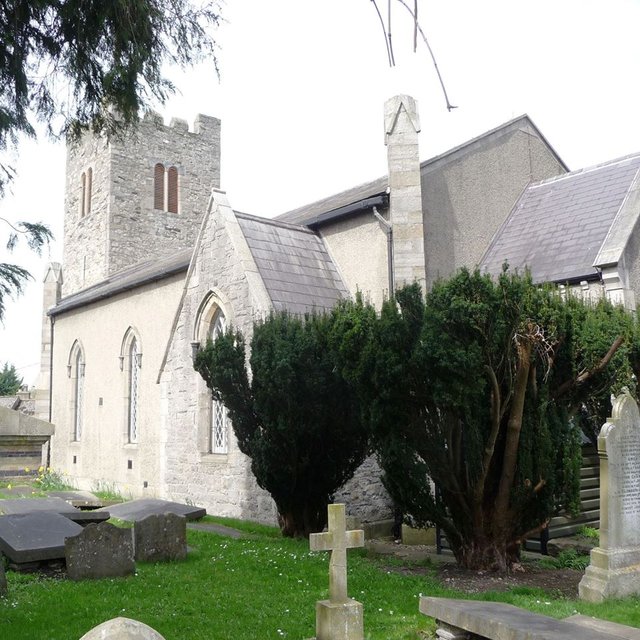
The present Church of St Laurence was constructed in 1832, but the neighbouring tower dates from the 14th century. It is believed that two earlier Norman chapels stood on the same spot. The Anglican Church of St Laurence was named for the patron saint of Dublin, Lorcán Ua Tuathail (Laurence O’Toole), who was Archbishop of Dublin at the time of the Norman Invasion. The church and tower are all but hidden by the famous House by the Churchyard.
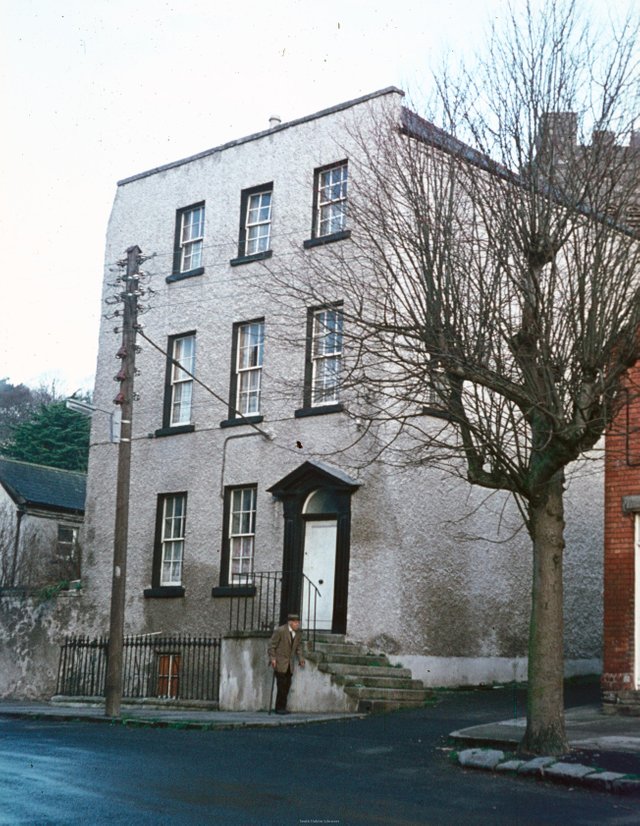
The Catholic Church of the Nativity of the Blessed Virgin Mary—formerly St Mary’s Church—stands on the outskirts of the village. It was built in the 1840s.
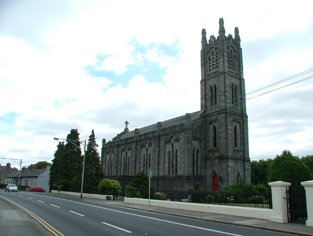
As for Isolde and her chapel ... the search continues.
The Joyce Connection
James Joyce’s associations with Chapelizod can be traced back to the 1870s—a few years before he was born—through his father John Stanislaus Joyce:
About the year 1877 John Joyce entered into negotiations with Henry Alleyn, a Cork man and a friend of his father’s, who was organizing the Dublin and Chapelizod Distilling Company. The company needed money and Joyce offered to buy £500 of shares on condition that he be appointed secretary at £300 a year. The directors agreed, and he was soon working every day in the old building on the Liffey at Chapelizod which, having served as a convent, a soldiers’ barracks, and a flax factory owned by William Dargan, was now a distillery. (Ellmann 16)
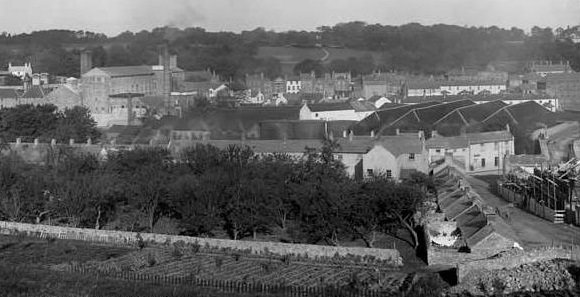
The Dublin and Chapelizod Distilling Company failed after three years and Joyce lost both his investment and his sinecure, but The Distillers Company of Scotland resurrected the business a few years later as the Phoenix Park Distillery.
Ellmann’s About the year 1877 is a little vague. The Dictionary of Irish Architects records that Edward Henry Carson—father of the famous politician of the same name—converted the flax mill into a distillery in 1874, citing The Irish Builder and The Builder as sources:
NOTES OF WORKS ... Considerable alterations and additions are now in progress for converting the flax mills situated at Chapelizod, County Dublin, formerly belonging to Messrs. W. Dargan and Co., into a distillery. A detailed account of this extensive undertaking will be given in a future number of the IRISH BUILDER. (Roe 57, Godwin 151)
The Distillers Company acquired the distillery in 1878:
Works executed at the Phoenix Park Distillery, Chapelizod, Dublin—These buildings were erected
by Wm. Dargan, of railway fame, in the year 1856, as a flax factory, and were acquired by the Distillers Co., Ltd., 12 Torphichen-street, Edinburgh, in 1878, who converted the premises into a distillery at a cost of between £30,000 and £40,000. (Butler 860)
So it would appear that John Joyce’s stint as secretary of the Chapelizod distillery lasted from 1875 to 1878.
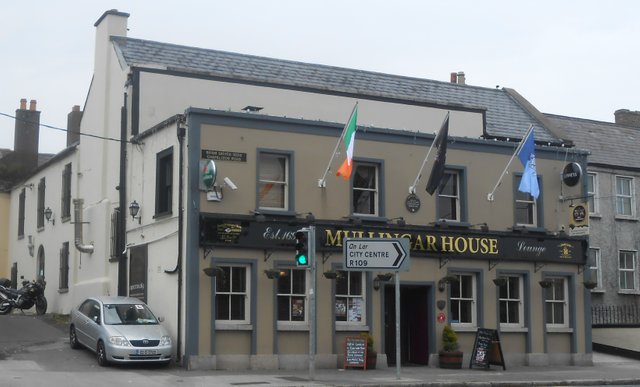
On the eastern outskirts of Chapelizod is a public house known today as the Mullingar House. A century ago it was The Mullingar Hotel. This was the coaching inn where commuters from Dublin embarked for Mullingar in the centre of the country. It occupied the same plot of ground as an earlier pub, The Phoenix, which was featured in Le Fanu’s novel. The Mullingar Hotel became John Joyce’s principle watering-hole in Chapelizod. According to James Joyce’s nephew Ken Monaghan , John Joyce spent most of the three years he worked as secretary of the distillery in the Mullingar House (Irish Times 5 March 1999):
He spent more time in the bar of the Mullingar House Hotel than he did in his office in the distillery. The Hotel was owned at that time by an Englishman named Broadbent and Jack Joyce’s stories about Broadbent and his family and the village of Chapelizod inspired James Joyce to write Finnegans Wake where the central character, Humphrey Chimpden Earwicker, is an innkeeper from Chapelizod. (Monaghan 22)
In those days Robert Broadbent, the landlord of the establishment, was about fifty years old. He was married with two sons and three daughters.
[John Joyce’s] stories about Broadbent, who had the Mullingar Hotel (now Mullingar House) there, helped his son James to construct Finnegans Wake around a hero who is a Chapelizod innkeeper. (Ellmann 16)
One such story has survived in an interview that John Stanislaus Joyce is alleged to have given to an unidentified journalist in 1930 or ’31. It was found among Joyce’s papers in Paris after his death and published by Maria Jolas in 1949 in A James Joyce Yearbook:
Broadbent and I were very great friends. He had the Mullingar Hotel there, and a fine decent fellow he was. We used to have great times there. There was a bowling green at the back of his hotel and I was considered a celebrated bowler...On one occasion Dollymount challenged us to a game. We won and we stood them food and drink after it. This was followed by a splendid musical evening as we had a lot of musical fellows down with us ... We beat Dollymount and I made a big score; and by God I was carried around the place and such a time we had ... I was made a lot of and was taken around by the boys on their shoulders; and my God the quantity of whisky that I drank that night! It must have been something terrible for I had to go to bed. I was not very long in bed when half a dozen of the fellows came up to me and said that they were having a singsong downstairs, adding: “Come on, Jack, don’t have them beat us at the singing” ... Begor I could not walk so I told them to clear out to Blazes ... (Jolas 159-169)
The authenticity of this interview has been challenged and today it holds little credibility in Joycean circles. It is persistently rumoured that the whole thing was concocted as a practical joke by Brian O’Nolan. Nevertheless, it was found among James Joyce’s papers, so even if it is fake, it is still possible that Joyce drew inspiration from it. See Heckard for an overview of the controversy and Scholes & Kain (119 ff) for a partial transcript.
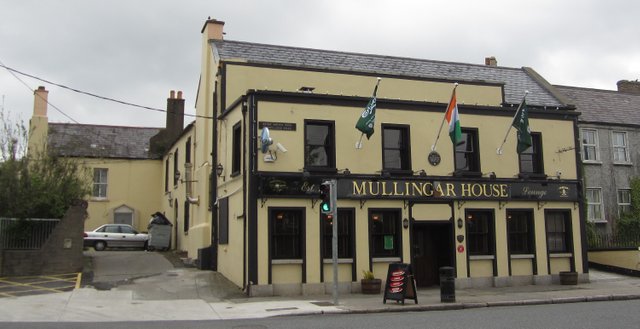
the whole history of that Mullingcan Inn
Finnegans Wake is set in the Mullingar House—more or less. John Gordon, quondam professor at Connecticut College, sets the scene in his book Finnegans Wake: A Plot Summary:
The centre of the action is a building called the Mullingar House, so named because in coaching days it was the setting-out point for travellers to Mullingar. It still stands. Like the inn of Finnegans Wake, it is a three-storey structure, painted white ... sharing a “party wall” with a building to the (approximate) “South” ... with a backyard large enough to contain chickens ... and, in earlier times, a privy. Because the construction is irregular—there is an addition to the front whose floors, due to the slant of the ground, do not exactly match those of the older structure—and because modifications have been made since Joyce’s time, it is probably futile to look for exact correspondences between the layout of the present structure and that of the Wake’s inn. (Gordon 10)
The two-storey frontage is a recent addition, but in earlier times the area in front of the main building was occupied by stables and a yard.
... the Mullingar lies northwest by southeast in the shape of a stunted L—a rectangle with an extension backward from the northwest end ... There is a second party wall at the northeast end of this extension, joining the Mullingar with a building called “Rose Cottage”. (Gordon 10)
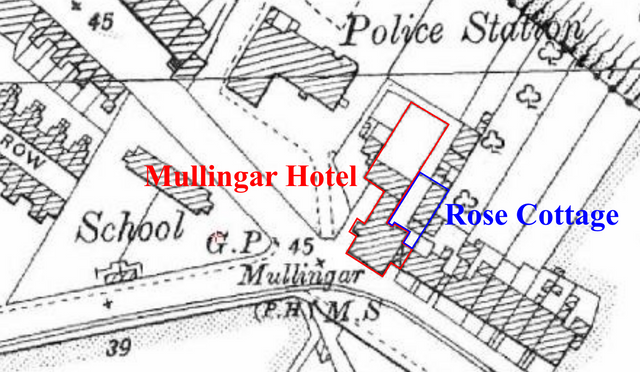
Access to the Rose Cottage is via a lane behind the Hotel. Note that Gordon’s stunted L is actually a sort of Z, with an additional two-storey extension at the top of the L. This extension appears on 19th-century maps, so it is not a post-Joycean addition:
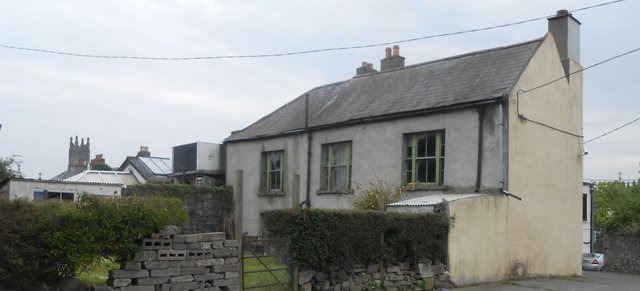
When Joyce wrote Ulysses he went to great lengths to get the details right. He had an extraordinary memory for the minutiae of everyday life, which he supplemented with information culled from the pages of Thom’s Official Directory. And if all else failed, he had numerous relatives and acquaintances in Dublin who could verify details for him on the spot. His Aunt Josephine—the wife of his mother’s brother William Murray—was particularly useful to him in this regard:
At one time Joyce was anxious to find out concerning the Star-of-the-Sea church at Sandymount which is mentioned in the Nausicaa episode of Ulysses—if the surrounding trees would be visible from the shore and if there were steps leading down at the side of it from Leahy’s Terrace. It would seem that Aunt Josephine put on bonnet or hat and went down to Sandymount. (Hutchins 71)
Joyce continued to draw upon his Aunt Josephine’s memory and local knowledge while writing Finnegans Wake. In December 1922 he wrote to her for information on various people connected with his family:
I wonder if I sent you an exercise book with the names of these persons at the tops of the pages would you be kind enough (whenever you have a spare moment and anything occurs to your mind) to scribble down in pencil or pen anything noteworthy, details of dress, defects, hobbies, appearance, manner of death, voice, where they lived, etc just as you did for the questions I sent you about Major Powell—in my book Major Tweedy, Mrs Bloom’s father? They all belong to a vanished world and most of them seem to have been very curious types. (Letters 21 December 1922)
Note that Joyce is now principally interested in characters, not geographical or architectural precision. There is no evidence that he ever inquired about such details in relation to the Mullingar Hotel. It is probably pointless to research, say, the floor plans or architecture of this building and use the resulting information to locate the events of Finnegans Wake in space and time. The public house in Finnegans Wake was inspired by the Mullingar House, and resembles it in many respects, but it is not the Mullingar House.
In fact, we know that the Mullingar House was Joyce’s principal model for the setting of Finnegans Wake but not his only model. In one of his seminal works on Finnegans Wake, Roland McHugh included the following illuminating detail while discussing III.4:
The first tableau takes in only the interior of [the protagonist’s] house or pub. This, according to 064.09, might be the Mullingar Inn in Chapelizod, a region of Dublin named from Isolde, who was said to have had a bower and a chapel there. A letter of 5 May 1933 from Lucia Joyce to Frank Budgen confirms this: “The principal bistro, he [Joyce] says, was the Mullingar Inn, of which in W.i.P. [Work in Progress] the big man is assumed to be landlord.” (McHugh 24)
So the Mullingar Inn is only the principal setting, not necessarily the only one.
In Finnegans Wake the Mullingar House becomes a microcosm of human society. The three storeys are distributed among the three generations of the landlord’s household: the children’s rooms are on the top floor, the parents sleep in the master bedroom on the middle floor, and the elderly manservant and maid-of-all-work occupy the downstairs. John Joyce’s bowling green at the rear—if it ever existed—doubles as Uncle Toby’s bowling green in Laurence Sterne’s Tristram Shandy, where he and Corporal Trim re-enact the Siege of Namur.
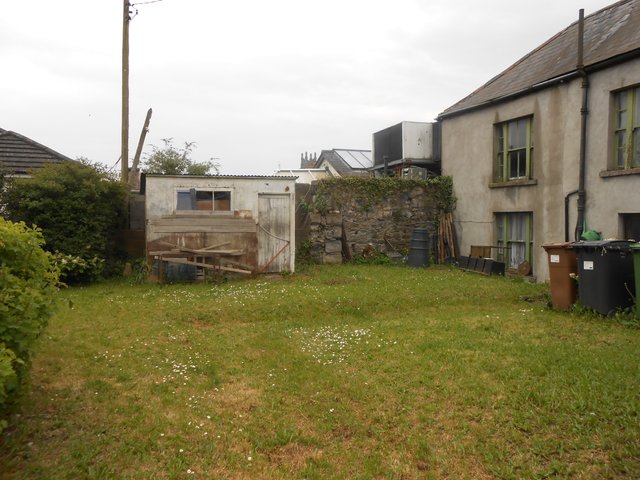
References
- R M Butler (editor), The Irish Builder, Volume 43, Number 1001, 15 September 1901, pp 860-861, Howard MacGarvey & Sons, Dublin (1901)
- Francis Elrington Ball, A History of the County Dublin, Volume 4, Alexander Thom & Co Ltd, Dublin (1906)
- Richard Ellmann, James Joyce, Oxford University Press, Oxford (1982)
- Don Gifford, Joyce Annotated: Notes for Dubliners and A Portrait of the Artist as a Young Man, University of California Press, Berkeley (1982)
- George Godwin (editor), The Builder, Volume 32, Number 1620, 21 February 1874, p 151, London (1874)
- John Gordon, Finnegans Wake: A Plot Summary, Syracuse University Press, Syracuse NY (1986)
- Margaret Heckard, The Literary Reverberations of a Fake Interview with John Stanislaus Joyce, James Joyce Quarterly, Volume 13, Number 4 (Summer 1976), pp 468-471, University of Tulsa, Tulsa OK (1976)
- Patricia Hutchins, James Joyce’s World, Routledge, Abingdon, Oxfordshire (2016)
- Maria Jolas, A James Joyce Yearbook, Transition Press, Paris (1949)
- James Joyce, Finnegans Wake, Faber & Faber Limited, London (1939)
- James Joyce et al, The Letters of James Joyce, Volumes I, II, III, Stuart Gilbert (editor), Richard Ellmann (editor), Viking Press, New York (1966)
- Roland McHugh, The Sigla of Finnegans Wake, University of Texas Press, Austin TX (1976)
- Louis O Mink, A Finnegans Wake Gazetteer, Indiana University Press, Bloomington IN (1978)
- Ken Monaghan, My Home Was Simply a Middle-Class Affair: Joyce’s Dublin Family, Harrassowitz Verlag, Wiesbaden (2000)
- Peter Roe (editor), The Irish Builder, Volume 16, Number 340, 15 February 1874, p 57, Howard MacGarvey & Sons, Dublin (1874)
- James Joyce, Danis Rose (ed), John O’Hanlon (ed), The Restored Finnegans Wake, Penguin Classics, London (2012)
- Robert Scholes, Richard M Kain, The Workshop of Daedalus, Northwestern University Press, Evanston IL (1965)
Image Credits
- Map of Chapelizod: © Ordnance Survey Ireland, Fair Use
- St Laurence’s Tower: Public Domain
- Chapelizod Village Square in 1900: Wikimedia Commons, © Marchofwales, Creative Commons License
- St Laurence’s Church and Tower: © St Laurence’s Church, Fair Use
- The House by the Churchyard: © Patrick Healy, Fair Use
- The Church of the Nativity of the Blessed Virgin Mary: © Department of Arts, Heritage and the Gaeltacht, Fair Use
- Chapelizod and the Phoenix Park Distillery: Unknown Copyright, Fair Use
- Mullingar House: Public Domain
- Mullingar House: © pegasus, Fair Use
- Map of the Mullingar House & Environs: © Ordnance Survey Ireland, Fair Use
- The Two-Storey Extension at the Rear of the Mullingar House: Public Domain
- Back Garden of the Mullingar House: Public Domain